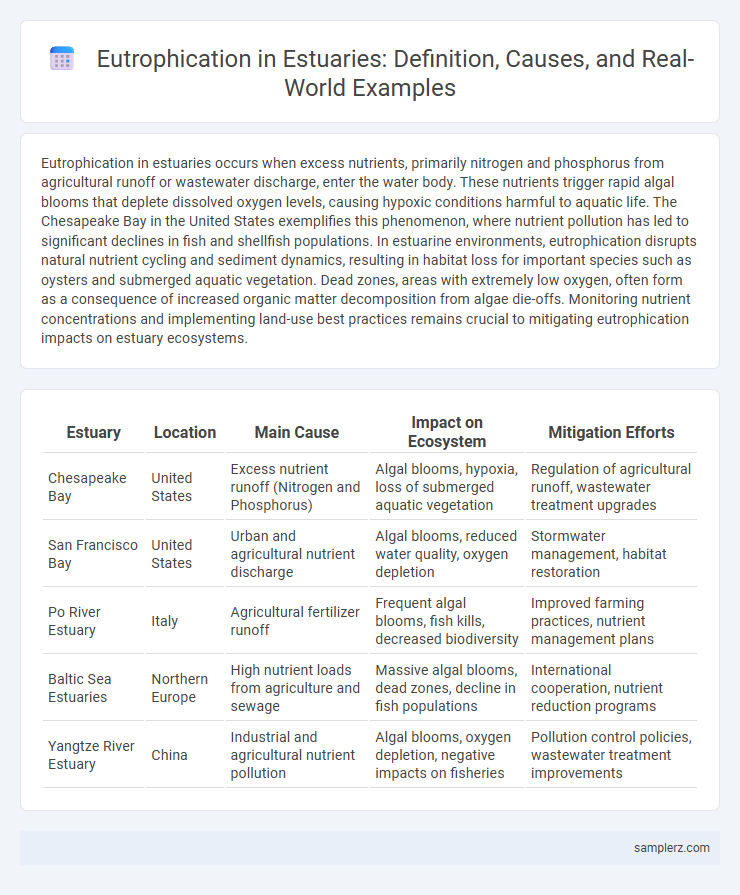Eutrophication in estuaries occurs when excess nutrients, primarily nitrogen and phosphorus from agricultural runoff or wastewater discharge, enter the water body. These nutrients trigger rapid algal blooms that deplete dissolved oxygen levels, causing hypoxic conditions harmful to aquatic life. The Chesapeake Bay in the United States exemplifies this phenomenon, where nutrient pollution has led to significant declines in fish and shellfish populations. In estuarine environments, eutrophication disrupts natural nutrient cycling and sediment dynamics, resulting in habitat loss for important species such as oysters and submerged aquatic vegetation. Dead zones, areas with extremely low oxygen, often form as a consequence of increased organic matter decomposition from algae die-offs. Monitoring nutrient concentrations and implementing land-use best practices remains crucial to mitigating eutrophication impacts on estuary ecosystems.
Table of Comparison
| Estuary | Location | Main Cause | Impact on Ecosystem | Mitigation Efforts |
|---|---|---|---|---|
| Chesapeake Bay | United States | Excess nutrient runoff (Nitrogen and Phosphorus) | Algal blooms, hypoxia, loss of submerged aquatic vegetation | Regulation of agricultural runoff, wastewater treatment upgrades |
| San Francisco Bay | United States | Urban and agricultural nutrient discharge | Algal blooms, reduced water quality, oxygen depletion | Stormwater management, habitat restoration |
| Po River Estuary | Italy | Agricultural fertilizer runoff | Frequent algal blooms, fish kills, decreased biodiversity | Improved farming practices, nutrient management plans |
| Baltic Sea Estuaries | Northern Europe | High nutrient loads from agriculture and sewage | Massive algal blooms, dead zones, decline in fish populations | International cooperation, nutrient reduction programs |
| Yangtze River Estuary | China | Industrial and agricultural nutrient pollution | Algal blooms, oxygen depletion, negative impacts on fisheries | Pollution control policies, wastewater treatment improvements |
Overview of Eutrophication in Estuaries
Eutrophication in estuaries occurs when excessive nutrients, primarily nitrogen and phosphorus from agricultural runoff and wastewater discharge, stimulate rapid algal blooms that deplete oxygen levels. This oxygen depletion, or hypoxia, severely impacts aquatic life, leading to fish kills and loss of biodiversity in critical habitats like the Chesapeake Bay and the Gulf of Mexico estuaries. Monitoring nutrient loads and implementing management strategies are essential to mitigate eutrophication effects and restore estuarine ecosystem health.
Key Drivers of Estuarine Eutrophication
Excessive nutrient inputs, primarily nitrogen and phosphorus from agricultural runoff and wastewater discharge, drive eutrophication in estuaries like the Chesapeake Bay. These nutrients stimulate algal blooms that deplete dissolved oxygen, harming aquatic life and disrupting ecosystem balance. Land use changes and urban development further exacerbate nutrient loading, intensifying estuarine eutrophication processes.
Case Study: Chesapeake Bay Eutrophication
Chesapeake Bay, the largest estuary in the United States, experiences significant eutrophication driven by nutrient pollution primarily from agricultural runoff and urban wastewater. Excess nitrogen and phosphorus fuel algal blooms that deplete oxygen levels, creating hypoxic zones detrimental to aquatic life such as blue crabs, oysters, and striped bass. Restoration efforts focus on reducing nutrient loads through improved land management practices, wastewater treatment upgrades, and monitoring programs to restore water quality and ecosystem health.
Nutrient Sources Contributing to Estuarine Eutrophication
Nutrient sources contributing to estuarine eutrophication primarily include agricultural runoff, urban wastewater discharge, and atmospheric deposition. Excess nitrogen and phosphorus from fertilizers, septic systems, and stormwater increase nutrient loads, promoting harmful algal blooms in estuaries such as the Chesapeake Bay. These nutrient inputs disrupt aquatic ecosystems by reducing oxygen levels, causing fish kills, and degrading water quality.
Impact of Agricultural Runoff on Estuaries
Agricultural runoff introduces excessive nutrients like nitrogen and phosphorus into estuaries, triggering eutrophication that depletes oxygen levels and harms aquatic life. This nutrient overload causes algal blooms, which block sunlight and disrupt photosynthesis for submerged vegetation, altering the ecosystem balance. The resulting hypoxic conditions lead to fish kills and loss of biodiversity, severely impacting estuarine fisheries and water quality.
Algal Blooms: Indicator of Eutrophic Estuaries
Algal blooms in estuaries such as the Chesapeake Bay serve as critical indicators of eutrophic conditions driven by excess nutrient inputs, particularly nitrogen and phosphorus from agricultural runoff and urban wastewater. These blooms, dominated by species like cyanobacteria and dinoflagellates, cause oxygen depletion and disrupt aquatic ecosystems. Monitoring algal bloom frequency and intensity provides valuable data for managing nutrient pollution and restoring estuarine health.
Consequences for Fish and Marine Biodiversity
Eutrophication in estuaries causes oxygen depletion, leading to hypoxic conditions that severely reduce fish populations and disrupt marine biodiversity. Excess nutrient runoff promotes algal blooms, which block sunlight and alter habitat quality critical for aquatic life. The decline in species diversity and abundance threatens the overall ecological balance and fisheries productivity in affected estuarine environments.
Socioeconomic Effects of Eutrophication in Estuarine Areas
Eutrophication in estuarine areas, such as the Chesapeake Bay, leads to hypoxic zones that decimate fish populations, severely impacting local fisheries and commercial livelihoods. The decline in water quality reduces recreational opportunities and property values, causing economic losses in tourism-dependent communities. Increased costs for water treatment and habitat restoration further strain municipal budgets and local economies.
Strategies for Mitigating Eutrophication in Estuaries
Implementation of buffer zones with native vegetation along estuary shorelines effectively reduces nutrient runoff from adjacent agricultural lands, mitigating eutrophication. Aeration systems enhance oxygen levels in water, preventing hypoxic conditions detrimental to aquatic life in estuarine ecosystems. Regulatory measures limiting phosphorus and nitrogen emissions from industrial and urban sources significantly decrease nutrient loading, improving water quality and estuarine health.
Monitoring and Assessment of Estuary Health
Eutrophication in estuaries, such as the Chesapeake Bay, is monitored through regular measurements of nutrient concentrations, dissolved oxygen levels, and algal biomass using remote sensing and in-situ water quality sensors. Assessment protocols integrate data from continuous monitoring stations and periodic biological surveys to evaluate the severity of hypoxic zones and the impact on biodiversity. Advanced modeling techniques help predict eutrophication trends, guiding management strategies to restore estuarine health and improve water quality.

example of eutrophication in estuary Infographic
 samplerz.com
samplerz.com